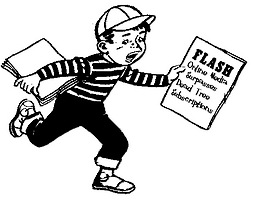 The print media continues to struggle in the face of the combined onslaught of economy and Internet. We get mighty few clues on how the fishing press is faring as so few are publicly traded.
The print media continues to struggle in the face of the combined onslaught of economy and Internet. We get mighty few clues on how the fishing press is faring as so few are publicly traded.
With Reader’s Digest filing Chapter 11, swapping debt for equity with its lenders, and numerous newspapers opting for digital only, it’s plain the effect is significant.
Even so, Reader’s Digest, the iconic monthly magazine founded in 1922 as a collection of condensed articles from other publications, has been searching for a new niche as the Internet upends the magazine industry’s traditional business models.
… and for each magazine shuttering its doors we have an electronic startup of the likes of This is Fly, Fish Can’t Read, or Catch – which by comparison enjoy miniscule costs and produce equal or better quality.
If I was a collector I’d be disappointed in the slow but steady transition from print to digital, but as each site archives their past issues for ready access I find it much easier to find the article I wanted to reread – or the pattern I wanted to tie – and they’re not cluttering my tying bench or causing domestic issues when I discover my dog eared trove tossed in the trash.
They won’t always be free – the coming revolt with the “per click” revenue model will be short and violent. Until then they’re best consumed hunkered in your cubicle with a soggy sandwich chaser.
Tags: Fish Can’t Read, This is Fly, Catch, Reader’s Digest, ezine, Chapter 11, debt for equity swap, Web 2.0, online angling magazines, per click revenue, redirected eyeballs

The problems of READER’S DIGEST are certainly not just digital. Over seven decades the mag has degenerated into a dull tout sheet for the worst excesses of Capitalism, Christianity and Conservative “middle class values.” In case nobody has noticed, the thing is now end-to-end advertisements for geriatrics. I always keep my copy in the bathroom for its laxative properties. I don’t know where the hell I keep my sporting mags. Recycled, I guess.
Thanks for the mention in Singlebarbed. Todd Moen and I produce Catch Magazine and we try very hard to keep our content directed at a large segment of the fly fishing community, young and old. We show how dynamic, colorful and fun the sport is. Readers Digest lost it 10 years ago because they stayed with the Paul Harvey crowd, to the bitter end. On line magazines will continue to grow in popularity. We have advantages because of not using paper, ink or postage. An illuminated monitor is a great way to view photos and I have never seen video in a newspaper or magazine, except in Harry Potter movies.
@Yomama – As I get about 30 viagra spam a day, I’m wondering whether Reader’s Digest isn’t some sinister shadow entity – responsible for all the unwanted (geriatric) solicitations?
@Brian – The Paul Harvey reference is dead on. It’s still an amazing fall from 17 million subscribers to 5 – during a time when us geezers are supposedly on the increase.
Pingback: Travel writing is where you find it (but it may not be where you looked yesterday). « Sand Dollar Adventures